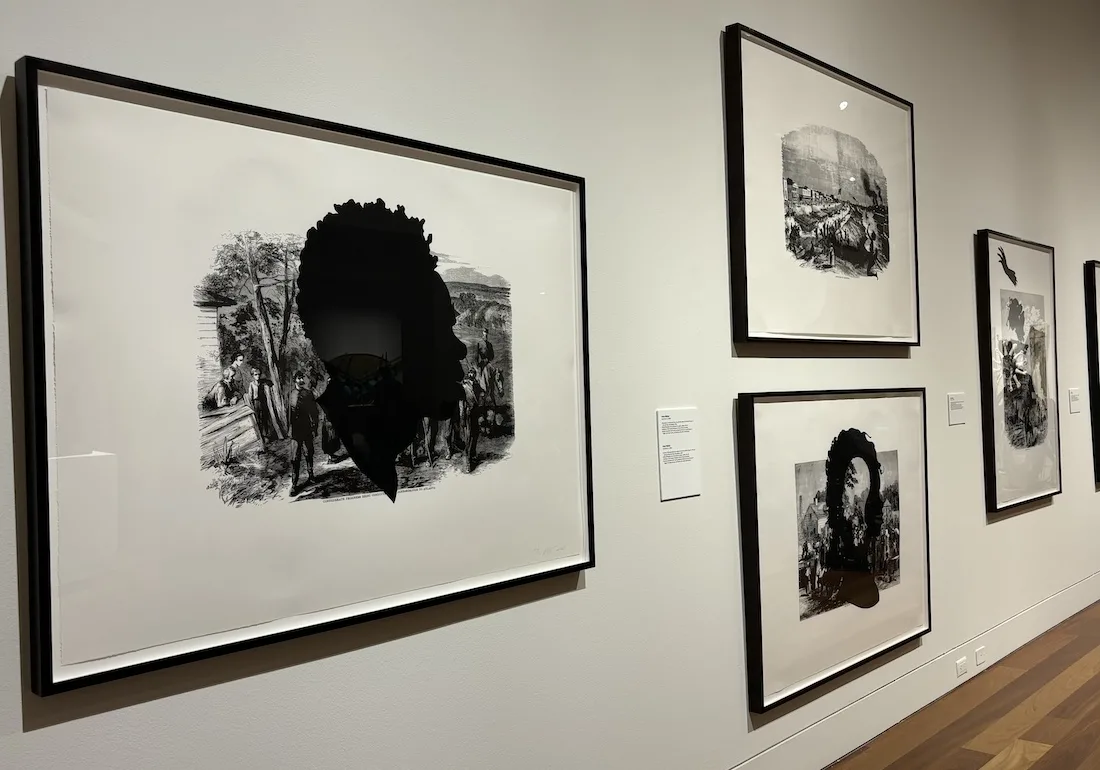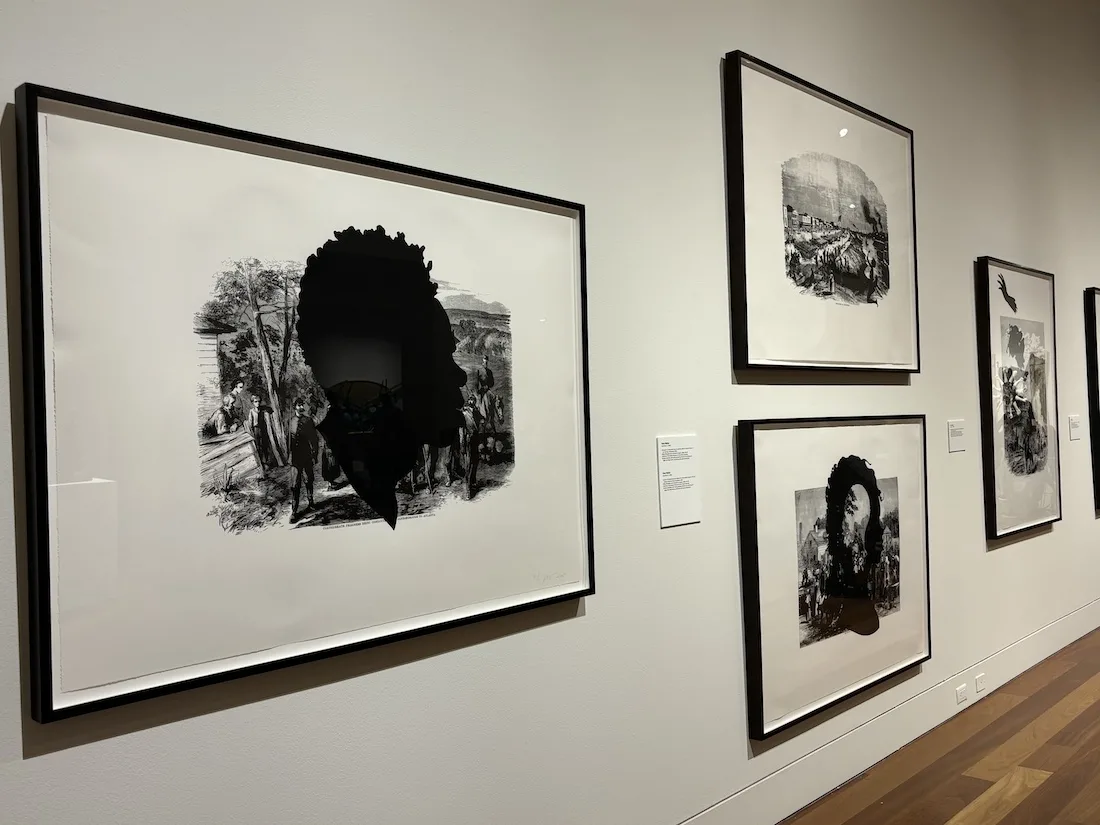
WILMINGTON — What do monuments say about society and what should be in museums and public spaces to help create a full picture of history and human value?
This is the conversation that took place at Cameron Art Museum Thursday evening for the opening of “Monument.”
It’s been a two-year project that new executive director Heather Wilson funded with a grant from the National Endowment of the Arts. “Monument” is a collection of works celebrating American and Black history, including abolitionists who freed slaves, victims of Wilmington’s 1898 Coup and Massacre, and those who fought for their own freedom during the Civil War.
The exhibition features work Stephen Hayes, Radcliffe Bailey, Augustus Saint-Gaudens, Kara Walker, Sonya Clark, and Alison Saar. It all started with Hayes’ “Boundless,” erected two years ago and highlighting the efforts fought by Black soldiers during the Civil War.
“I was really looking to create a fuller picture of a response to our built environment,” Wilson said, referring to the symbols that are erected in public spaces or within galleries. “And a response to what has been taught as history — from a feminine point of view, including Black females and males, and more contemporary voices.”
Wilson has wanted to show Walker’s work for years, she said. Regarded as one of the most successful modern Black artists, Walker is a painter, silhouettist, printmaker, and installation artist. Her work has been shown in the San Francisco MoMa and she was the youngest artist to receive a MacArthur Grant in 1997 at age 28.
Fifteen enlarged pages from historic textbook teachings on the Civil War in the Antebellum South hang in the CAM. The images are from the 1862-published “Harper’s Pictorial History of the Civil War,” more than 800 pages of scenes and maps detailing the military engagements of the era.
“It tells a very romanticized story of the Civil War,” Wilson said.
Some of the images overlook one crucial element in the history’s recounting: its effect on Black people.
Walker adds in their historical relevance by overlaying silhouettes of Black women and men onto “Harper’s” renderings in “Harper’s Pictorial History of the Civil War (Annotated)” from 2005.
Often the black-and-white images of the war feature soldiers at battle and descending upon townsfolk. The outline of a Black person’s face or body over the photo stands as a stark reminder that the war wasn’t fought without traumatic repercussions left upon enslaved people and their families.
“Kara makes these silhouettes that are often very stereotypical, almost caricature depictions of people of color,” Wilson described, adding some are created with wild hair, augmented lips, and pointed toes. “And she places them strategically over action that might be happening to emphasize it.”
Nearby “Monument” also features jars of soil collected by the Equal Justice Initiative, including two representing Wilmington and the victims of the 1898 Massacre and Coup. On Nov. 10, 1898, white supremacists with the Democratic Party overthrew the local Wilmington government, then led by an unofficial Fusionist party of Republicans and Populists, made up of both Black businessmen and white allies. Black locals were murdered and run out of their homes and businesses by the white supremacists.
Historians have called the massacre the only successful coup in U.S. history. Soil was collected at various places white supremacists killed and banished people from Wilmington — from the Cape Fear River, where bodies were thrown, to the location of The Daily Record, the only Black newspaper in the state at the time that was set ablaze.
Researcher Tim Pinnick was part of the New Hanover Community Remembrance Project, which collected the soil. It had a ceremony two years ago recognizing the victims.
“But once it was over in 2021, we all said: ‘It really isn’t — so what are we going to do?’” he told PCD.
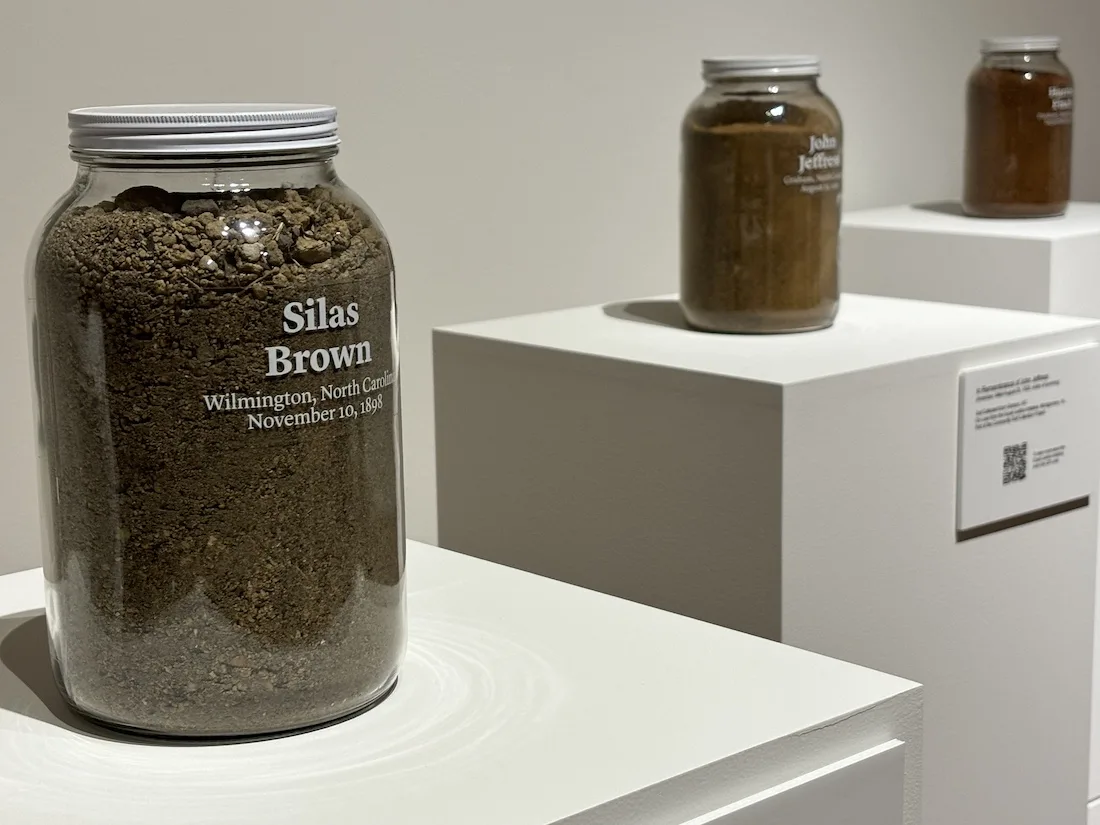
Pinnick continues his work with the Equal Justice Initiative and with the local Third Person Project to track living descendants of the victims of 1898. They have pulled from news articles, researched city directories and looked through historical documents.
“We’re building a genealogy of a community,” Pinnick said.
“Silas Brown” marks one of the jars on display in “Monument” — he’s one of roughly eight people that have been named as a victim, though historians have speculated dozens to hundreds were affected by the massacre. While Pinnick’s research has taken him far beyond the boundaries of Wilmington — Philadelphia, Brooklyn, Boston, Connecticut — he said, really, anyone who lived in Wilmington during 1898 was a victim.
“Nobody really has said it,” he said. “But every single person that we can place in Wilmington on November 10, 1898, was terrorized, so they all deserve to be tracked down and recognized.”
In front of the display of jars is a maquette of Harriett Tubman, created by Alison Saar, on loan from Yale University. A smaller version of the “Swing Low” memorial in Manhattan, it shows the Underground Railroad abolitionist pulling the shackles of oppression to an end. A front railroad gate peeks from the hem of her dress, as she pulls up the roots of slavery, with hundreds of faces of freed slaves rising in the folds of her dress.
On an opposite wall is Sonya Clark’s “Monumental Cloth.” The textile artist made a reproduction of the surrender flag.
“Imagine if that’s what was used as a symbol of the Civil War instead of the bars and stars,” Daniel Jones, CAM’s cultural curator, told a group touring through the exhibit Thursday.
Confederate General Robert E. Lee used a dishcloth to surrender to the Union Army during the Civil War in 1865. Clark’s replication — hand-woven, tea-stained linen, with red dye used on the three stripes at each end of the cloth — is meant to compel the viewer to reimagine if the Civil War symbol was remembered in truce. Instead, its Confederate battle flag has become synonymous with divisiveness, oppression and white supremacy.
Clark suggests the white flag promotes healing and reconciliation.
“Battle flags are meant to be seen across fields,” Clark told PBS in 2019. “This dishcloth was made to live in domestic space and absorb things. If we use that as a metaphor, what can this cloth absorb? What can it clean up?”
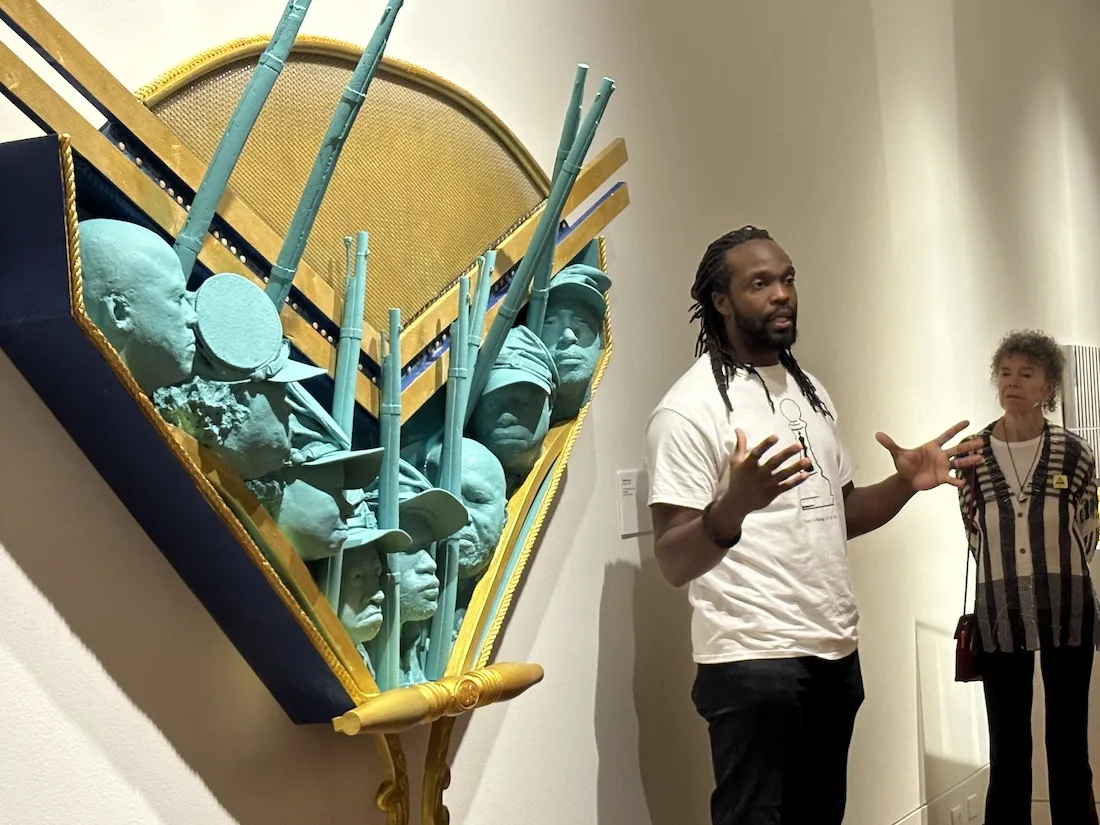
Stephen Hayes
The idea for “Monument” began when “Boundless” was erected on CAM’s grounds in 2021 — also the historic site where African American troops fought for their own freedom in the Battle of Forks Road in February 1865. It was one of the final battles the Union Army won in a Civil War skirmish that led to the Confederates’ fall in Wilmington.
To honor the men, Durham artist Hayes cast 11 people to create a line of Black soldiers marching in “Boundless.” The 2,500-pound bronze sculpture stands 16-feet-tall and is engraved with the names of the 1,820 men who served in the Union Army during the Civil War. They were part of the United States Colored Troops — of which 80% were enslaved men from the South. The USCT is honored in a park installed last year at CAM during the one-year anniversary of “Boundless.”
The timing of “Boundless” and the USCT Park is serendipitous. It was in the planning stages in 2018 yet officially unveiled to the public on the heels of 2020’s worldwide protests after George Floyd’s murder.
The public dialogue at the time heightened regarding Confederate statues and how their inclusion in public spaces can affect and represent — or misrepresent — society. The City of Wilmington removed two from the downtown area in 2021.
Hayes said when he does public space commissions, particularly in regard to Civil War history, he asks himself: “What is a conversation that ‘Boundless’ might have with other statues?”
The first move was to make it eye level, not on a pedestal as often seen in other war memorials. He said he didn’t want the soldiers “looking down” on others.
“I want people to see my work eye-to-eye,” he said, “so they can say, ‘We will live up to this and be better.’ It’s about encouragement.”
Thursday evening, CAM hosted a talk with Hayes and Dr. Valerie Johnson. Johnson, who has studied anthropology and sociology and is a dean of arts, sciences and humanities at Shaw University, wrote the essay for CAM’s “Monument” exhibition.
Johnson turned to Hayes: “When you say take them off the pedestal, put them on the ground, then it gets you thinking about: ‘Well, what does this ground mean to me, what is this place?’ And I think that goes back to my love of preservation of places that tell me stories.”
Johnson utilized Shaw University as an example. It’s home to the first Black female dormitory built in the nation in 1873.
“Women were coming to Shaw before women were allowed to go and matriculate at UNC Chapel Hill by many years,” she said.
It’s a living monument — kinetic, interactive, much like Hayes’ work, she compared.
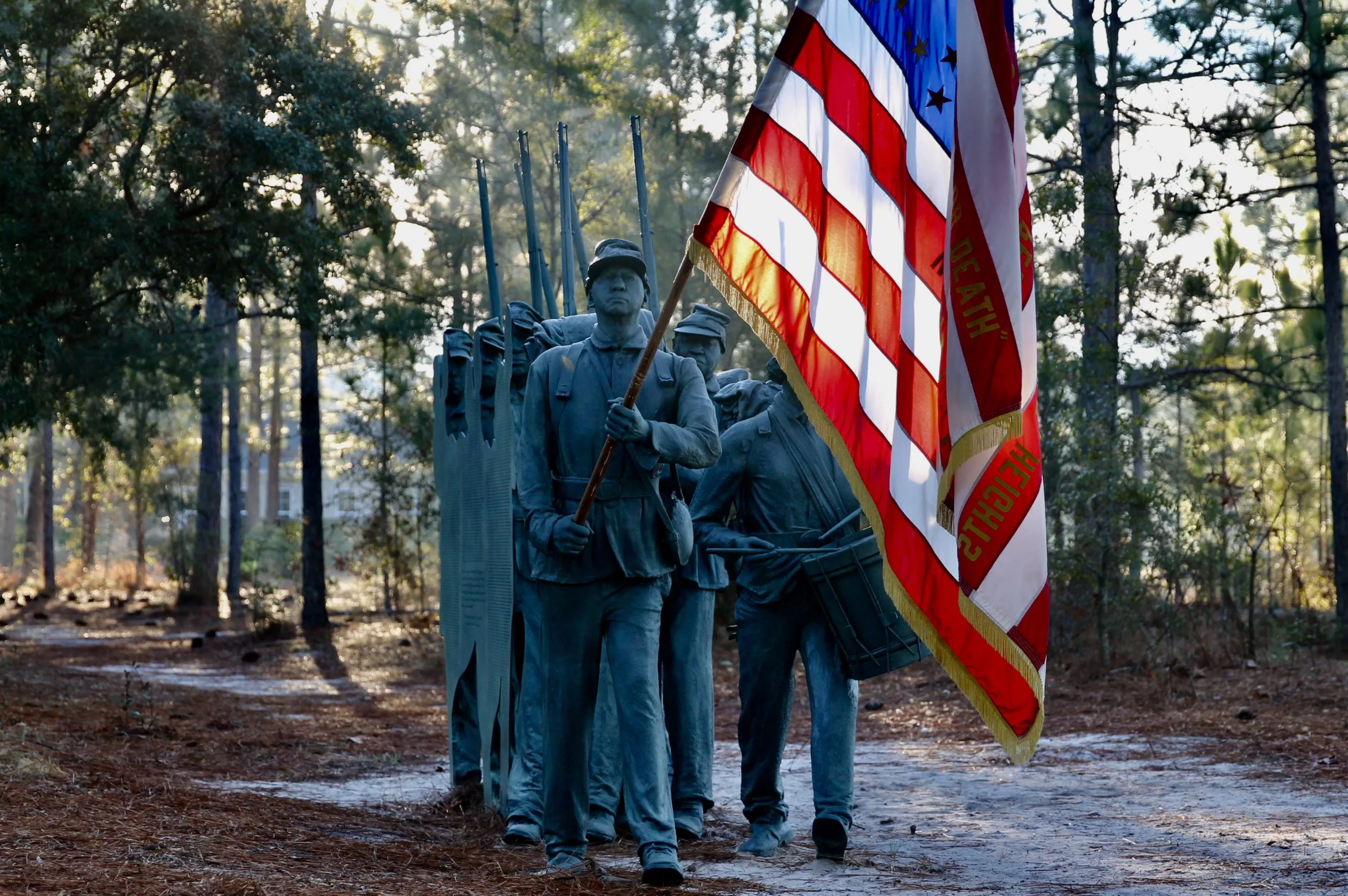
But sometimes history is only told through a one-sided lens or not afforded representation to understand the full scope. Johnson said the time is rife to change that.
She is part of the North Carolina Historical Commission, involved in conversations that took place about removing Confederate monuments in Raleigh in 2020. Johnson said with society’s evolution, dismantling “the mythmaking” of the Civil War — or any American history overlooking a people — Black, women, indigenous — should be considered more thoughtfully.
“How can we talk about war or history in a way that is serious and important, that does respect what happened and is factual?” she asked. “It’s a constant conversation because we are constantly changing as humans, and that’s the art of the give and take on these kinds of statues and monuments … But statues that were built to inspire terror — I’m talking about ones that were about oppressing people, at a particular time — they don’t belong in the public view. Period.”
Hayes cast 18 people for “Boundless” — descendants of soldiers or re-enactors of the USCT — but didn’t use all of the molds in the final work. The remaining seven casts have been reassembled in a new piece for CAM’s “Monument.”
“I knew I wanted to do something with them,” said Hayes, who has been conceptualizing and working on “He Who Would Be Free” for two years.
Seven cast heads — painted a green-blue to symbolize a worn patina look — further represent USCT soldiers, each outfitted with a uniform cap and rifled musket. The molds are framed in a life-sized Chevron, the V-shaped insignia that would have appeared on badges on their uniforms.
“This piece continues to create a badge of honor for these men,” he said.
One of the featured faces is Sonya Bennetone Patrick, who’s son Josiah was cast by Hayes a few years ago and featured in “Boundless.” Bennetone Patrick began researching her family history after learning she had a relative who fought in the Civil War and was buried in the Wilmington National Cemetery.
“I was so relieved when I found out he was fighting on the right side of justice,” she told PCD during the reveal of “Boundless” in 2021.
She looks like a young soldier in “He Who Would Be Free.” Though soldiers were typically 18-to-45-year-old men, some as young as 12 served as cavalry buglers or drummer boys.
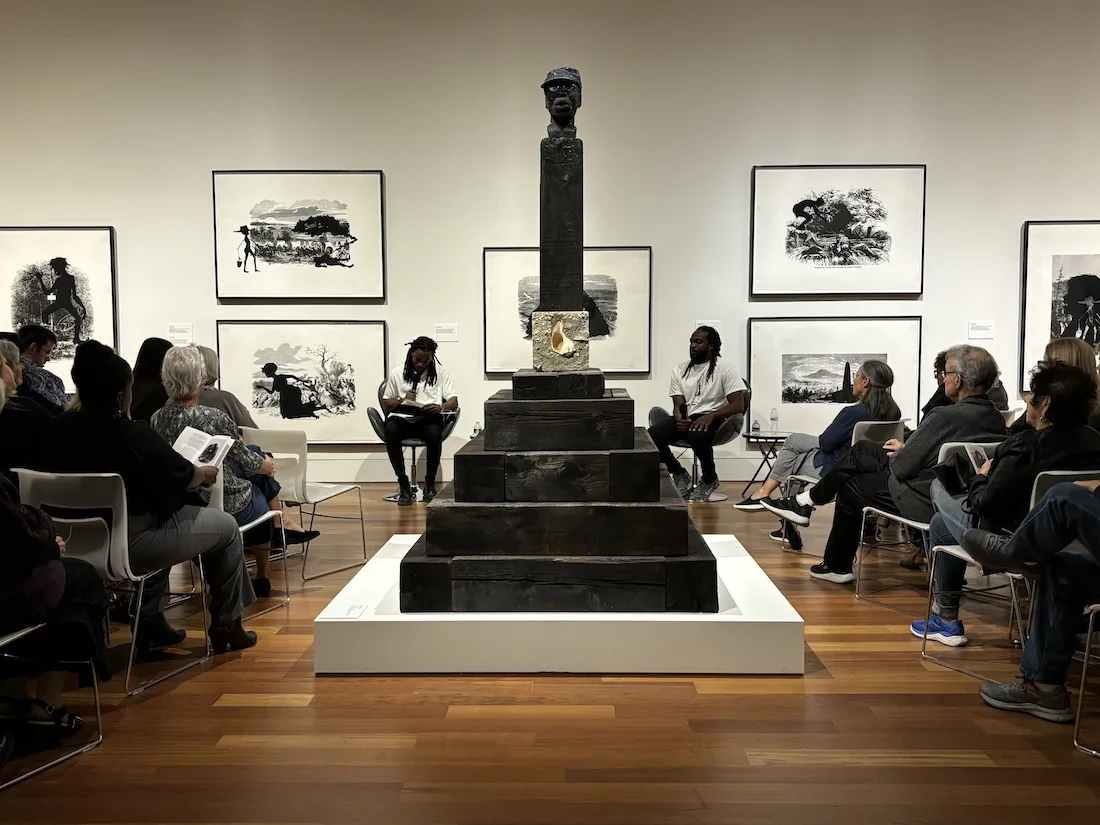
Descendants’ Oral Histories
Historians, such as Chris Fonvielle, have been working for years on researching the land CAM’s located on, which was once Federal Point Road, where USCT soldiers marched from Fort Fisher. What was once a few hundred records of USCT soldiers in the area has grown upward of thousands across nine regiments since research began 40 years ago.
“That’s not something you can just kind of edit into the story — as somebody has to rewrite from the beginning,” Jones told a crowd on a tour through the exhibit Thursday. “So how do we do that? How do we write the stories? You have to go talk to the people who kept these stories for generations.”
As part of “Monument,” Jones has been digging through Muster Rolls to find where men marched with the USCT. He then has been backtracking through genealogical research and connecting with local churches to find living descendants.
Wilson and her husband, Adam Alphin, an Emmy Award-winning filmmaker, began traversing the area to video the stories of people willing to go on record. The short film is being launched as part of “Monument” to bring to light histories that have gone untold or flew under the radar for so many years.
One piece features Rev. William H. Hunter, a Black chaplain for USCT, who helped St. Stephen African Methodist Episcopal, operational in Wilmington since 1865, become its own Black church.
Before the Civil War, African Methodism wasn’t prominent in the South and didn’t gain footing locally until the fall of Wilmington during the Civil War. Black parishioners worshiped as part of Front Street Methodist Church, South, led by a white pastor. But once Hunter preached to the churchgoers the Sunday after Wilmington’s fall from the Confederacy, they were free in more ways than one.
“A few short years ago, I left North Carolina a slave,” he said, recalling the church’s history. “I now return a man … I have the honor to be a regular minister of the Gospel … one week ago you were all slaves; now you are all free.”
More than 600 Black church members exited Front Street Methodist Church after its white pastor would not turn over the pulpit to Hunter to preach to the Black members. The Union Army granted a split of services between the congregations, and Stephen African Methodist Episcopal Church was born.
“He was the first minister of color that this parish had ever seen and gave them the confidence to start their church,” Wilson said.
CAM officials interviewed an indigenous man from Bertie County, as indigenous peoples fought in the USCT and also had someone from Massachusetts reach out while researching his own genealogy.
“He was a descendent of a white soldier in the USCT, but as he started doing his research, he found out that not only was he a descendant of the white soldier, his great great — however many greats — uncle was a USCT Black man who served here. So he found out in this process that he was of mixed race origin,” Wilson said.
The crew also interviewed the family of Caesar Evans — a slave in Brunswick County who fought in the USCT and saved up enough money over 15 years to buy back the land he once cultivated for his masters. It has been passed down through generations of family and today his descendants still own 238 acres in Bolivia.
Around 20 members of the Evans family will be at CAM during Descendents Homecoming on Saturday, Nov. 11.
“These stories are so powerful in the sense that they allow us to think about who gets to tell history,” Wilson said. “What point of view is my history being told from? Who gets the set to set the tone for what we think we know about where we come from?”
Events of Descendants Day Homecoming
Saturday, November 11
FREE Community Day
10 a.m. – 5 p.m.
Living History and USCT Reenactors on the Grounds
10 – 11:30 a.m.
Family Activities
11-11:30 a.m.
USCT Reenactor Clark Morgan of the Ohio 5th Speaks at Boundless
Clark Morgan aka Sgt Maj Milton Murray is a Civil War historian and presenter for the past 20 years focusing on the 5th USCT. He and other members (of the reorganized 5th) travel the country telling the untold stories of these great men of valor. Not just the military activities but other aspects of African Americans life in the mid-19th century.
11 a.m. – noon
Spanish Language Tour
Noon
Gospel Selection by Dr. Andrena Evans, USCT Descendant
12:30 p.m.
Premiere of a new short film chronicling the oral histories of USCT descendants, by filmmaker Adam Alphin
1:30 p.m
Lecture by Dr. Sherwin Bryant, Associate Professor of African American Studies and History, and Director of the Center for African American History at North Western University
3 p.m.
Tour of Boundless and the PNC USCT Park with Daniel Jones, CAM Cultural Curator
Sunday, November 12
1 p.m.
DREAMS Theatre of Wilmington Performance of Fighting for Freedom
Free with museum admission, director Lesa Broadhead, leads her ensemble of youth dancers to perform a dance, specially choreographed in response to the Boundless statue, Fighting for Freedom.
Tips or comments? Email info@localdailymedia.com.
Want to read more from PCD? Subscribe now and then sign up for our morning newsletter, Wilmington Wire, and get the headlines delivered to your inbox every morning.


